Comprehensive Analysis of Huawei's Management and Business Context
VerifiedAdded on 2022/10/02
|9
|1898
|219
Report
AI Summary
This report provides a comprehensive analysis of Huawei Enterprise USA, Inc.'s management and business context. It begins with an overview of the organization's structure, highlighting its customer-centric innovation and global presence. The report then delves into the business structure and governance, emphasizing Huawei's unique employee-owned model and rotating chairman system. Environmental factors, both internal and external, influencing the company are discussed, followed by an examination of top risks, including intentionally and unintentionally bad software, and broader business issues related to cultural differences and transparency. The report further explores Huawei's business practices, including its big data strategy, resource centralization, and channel refinement. It also covers the company's use of technologies and applications, such as its digital platform, and its approach to integrating digital and physical worlds. Other key areas include digitalization efforts, functional departments, research and development centers, sustainability management, and leadership strategies. The report concludes with a review of planning, organization, skill support, process operations, and performance appraisal, providing a holistic view of Huawei's operational and strategic landscape.
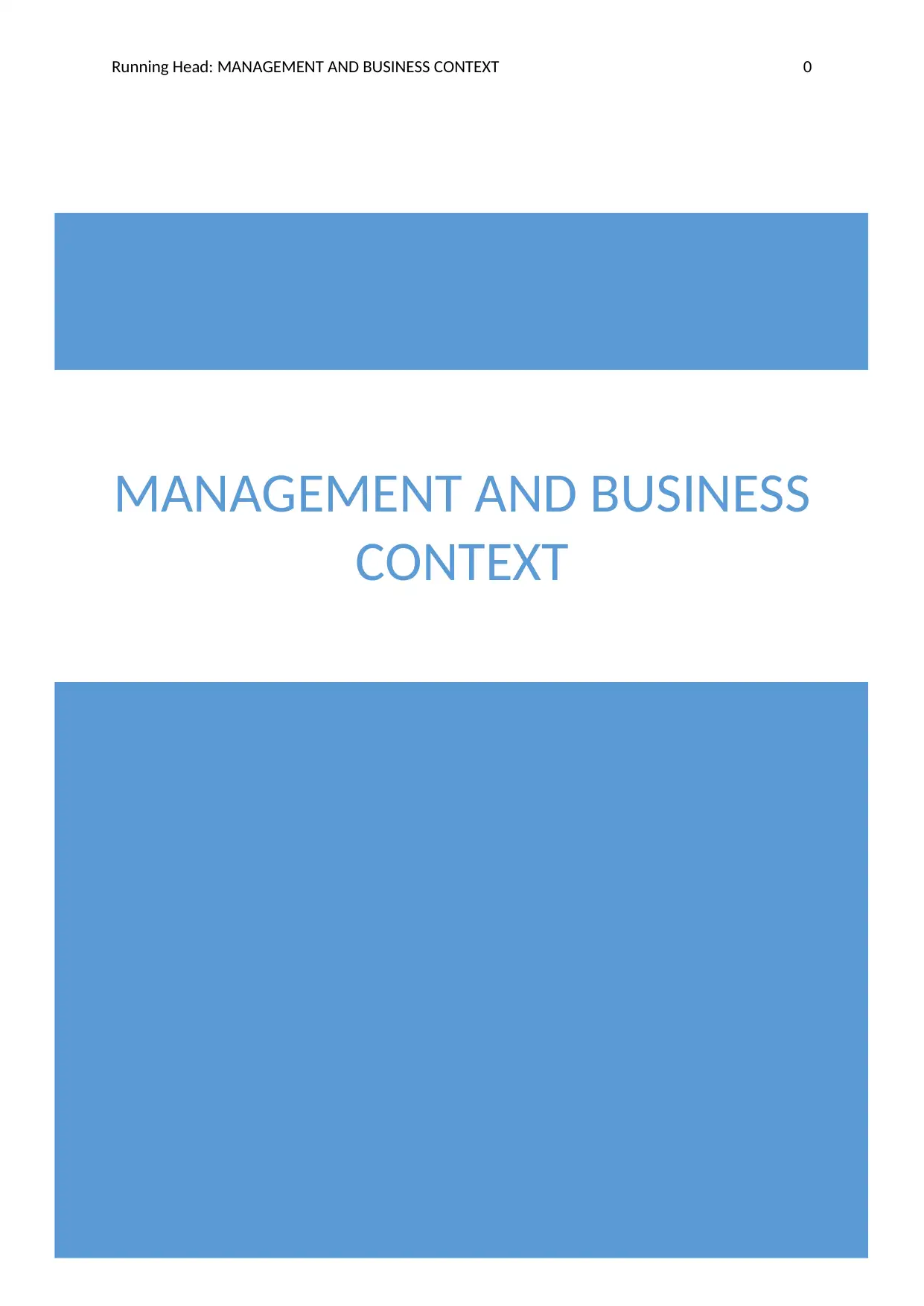
MANAGEMENT AND BUSINESS
CONTEXT
Running Head: MANAGEMENT AND BUSINESS CONTEXT 0
CONTEXT
Running Head: MANAGEMENT AND BUSINESS CONTEXT 0
Paraphrase This Document
Need a fresh take? Get an instant paraphrase of this document with our AI Paraphraser
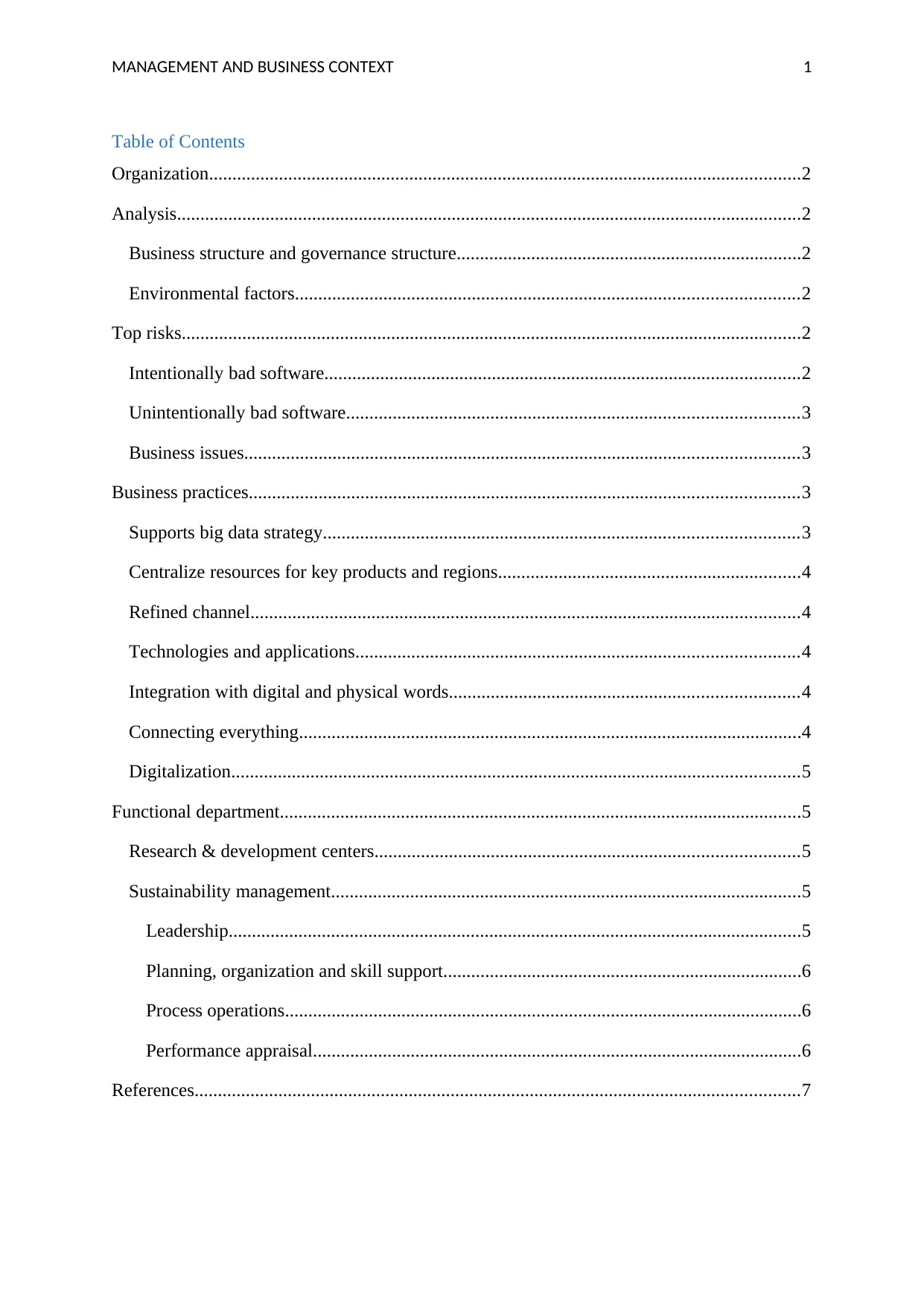
MANAGEMENT AND BUSINESS CONTEXT 1
Table of Contents
Organization...............................................................................................................................2
Analysis......................................................................................................................................2
Business structure and governance structure..........................................................................2
Environmental factors............................................................................................................2
Top risks.....................................................................................................................................2
Intentionally bad software......................................................................................................2
Unintentionally bad software.................................................................................................3
Business issues.......................................................................................................................3
Business practices......................................................................................................................3
Supports big data strategy......................................................................................................3
Centralize resources for key products and regions.................................................................4
Refined channel......................................................................................................................4
Technologies and applications...............................................................................................4
Integration with digital and physical words...........................................................................4
Connecting everything............................................................................................................4
Digitalization..........................................................................................................................5
Functional department................................................................................................................5
Research & development centers...........................................................................................5
Sustainability management.....................................................................................................5
Leadership...........................................................................................................................5
Planning, organization and skill support.............................................................................6
Process operations...............................................................................................................6
Performance appraisal.........................................................................................................6
References..................................................................................................................................7
Table of Contents
Organization...............................................................................................................................2
Analysis......................................................................................................................................2
Business structure and governance structure..........................................................................2
Environmental factors............................................................................................................2
Top risks.....................................................................................................................................2
Intentionally bad software......................................................................................................2
Unintentionally bad software.................................................................................................3
Business issues.......................................................................................................................3
Business practices......................................................................................................................3
Supports big data strategy......................................................................................................3
Centralize resources for key products and regions.................................................................4
Refined channel......................................................................................................................4
Technologies and applications...............................................................................................4
Integration with digital and physical words...........................................................................4
Connecting everything............................................................................................................4
Digitalization..........................................................................................................................5
Functional department................................................................................................................5
Research & development centers...........................................................................................5
Sustainability management.....................................................................................................5
Leadership...........................................................................................................................5
Planning, organization and skill support.............................................................................6
Process operations...............................................................................................................6
Performance appraisal.........................................................................................................6
References..................................................................................................................................7
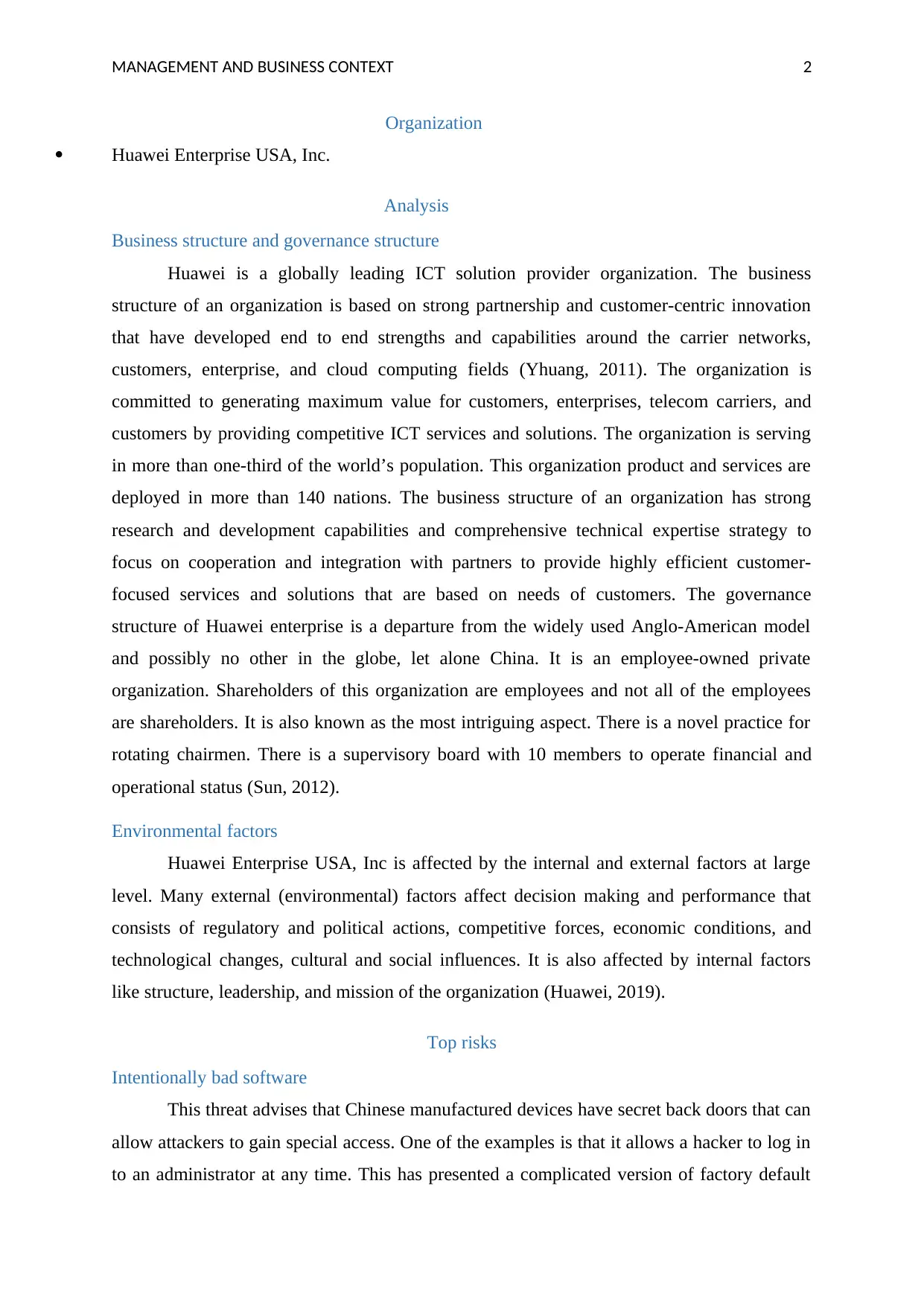
MANAGEMENT AND BUSINESS CONTEXT 2
Organization
Huawei Enterprise USA, Inc.
Analysis
Business structure and governance structure
Huawei is a globally leading ICT solution provider organization. The business
structure of an organization is based on strong partnership and customer-centric innovation
that have developed end to end strengths and capabilities around the carrier networks,
customers, enterprise, and cloud computing fields (Yhuang, 2011). The organization is
committed to generating maximum value for customers, enterprises, telecom carriers, and
customers by providing competitive ICT services and solutions. The organization is serving
in more than one-third of the world’s population. This organization product and services are
deployed in more than 140 nations. The business structure of an organization has strong
research and development capabilities and comprehensive technical expertise strategy to
focus on cooperation and integration with partners to provide highly efficient customer-
focused services and solutions that are based on needs of customers. The governance
structure of Huawei enterprise is a departure from the widely used Anglo-American model
and possibly no other in the globe, let alone China. It is an employee-owned private
organization. Shareholders of this organization are employees and not all of the employees
are shareholders. It is also known as the most intriguing aspect. There is a novel practice for
rotating chairmen. There is a supervisory board with 10 members to operate financial and
operational status (Sun, 2012).
Environmental factors
Huawei Enterprise USA, Inc is affected by the internal and external factors at large
level. Many external (environmental) factors affect decision making and performance that
consists of regulatory and political actions, competitive forces, economic conditions, and
technological changes, cultural and social influences. It is also affected by internal factors
like structure, leadership, and mission of the organization (Huawei, 2019).
Top risks
Intentionally bad software
This threat advises that Chinese manufactured devices have secret back doors that can
allow attackers to gain special access. One of the examples is that it allows a hacker to log in
to an administrator at any time. This has presented a complicated version of factory default
Organization
Huawei Enterprise USA, Inc.
Analysis
Business structure and governance structure
Huawei is a globally leading ICT solution provider organization. The business
structure of an organization is based on strong partnership and customer-centric innovation
that have developed end to end strengths and capabilities around the carrier networks,
customers, enterprise, and cloud computing fields (Yhuang, 2011). The organization is
committed to generating maximum value for customers, enterprises, telecom carriers, and
customers by providing competitive ICT services and solutions. The organization is serving
in more than one-third of the world’s population. This organization product and services are
deployed in more than 140 nations. The business structure of an organization has strong
research and development capabilities and comprehensive technical expertise strategy to
focus on cooperation and integration with partners to provide highly efficient customer-
focused services and solutions that are based on needs of customers. The governance
structure of Huawei enterprise is a departure from the widely used Anglo-American model
and possibly no other in the globe, let alone China. It is an employee-owned private
organization. Shareholders of this organization are employees and not all of the employees
are shareholders. It is also known as the most intriguing aspect. There is a novel practice for
rotating chairmen. There is a supervisory board with 10 members to operate financial and
operational status (Sun, 2012).
Environmental factors
Huawei Enterprise USA, Inc is affected by the internal and external factors at large
level. Many external (environmental) factors affect decision making and performance that
consists of regulatory and political actions, competitive forces, economic conditions, and
technological changes, cultural and social influences. It is also affected by internal factors
like structure, leadership, and mission of the organization (Huawei, 2019).
Top risks
Intentionally bad software
This threat advises that Chinese manufactured devices have secret back doors that can
allow attackers to gain special access. One of the examples is that it allows a hacker to log in
to an administrator at any time. This has presented a complicated version of factory default
⊘ This is a preview!⊘
Do you want full access?
Subscribe today to unlock all pages.

Trusted by 1+ million students worldwide
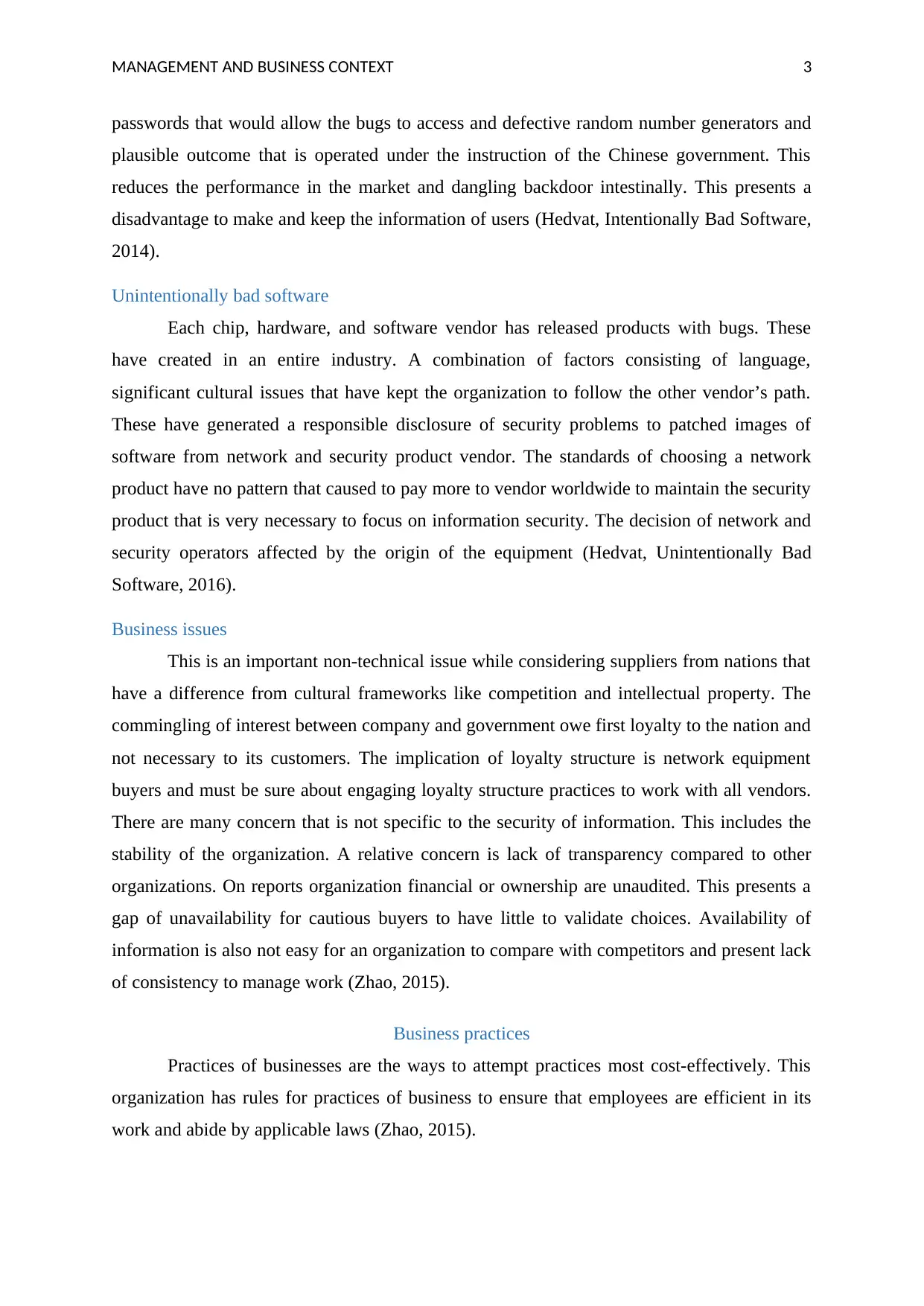
MANAGEMENT AND BUSINESS CONTEXT 3
passwords that would allow the bugs to access and defective random number generators and
plausible outcome that is operated under the instruction of the Chinese government. This
reduces the performance in the market and dangling backdoor intestinally. This presents a
disadvantage to make and keep the information of users (Hedvat, Intentionally Bad Software,
2014).
Unintentionally bad software
Each chip, hardware, and software vendor has released products with bugs. These
have created in an entire industry. A combination of factors consisting of language,
significant cultural issues that have kept the organization to follow the other vendor’s path.
These have generated a responsible disclosure of security problems to patched images of
software from network and security product vendor. The standards of choosing a network
product have no pattern that caused to pay more to vendor worldwide to maintain the security
product that is very necessary to focus on information security. The decision of network and
security operators affected by the origin of the equipment (Hedvat, Unintentionally Bad
Software, 2016).
Business issues
This is an important non-technical issue while considering suppliers from nations that
have a difference from cultural frameworks like competition and intellectual property. The
commingling of interest between company and government owe first loyalty to the nation and
not necessary to its customers. The implication of loyalty structure is network equipment
buyers and must be sure about engaging loyalty structure practices to work with all vendors.
There are many concern that is not specific to the security of information. This includes the
stability of the organization. A relative concern is lack of transparency compared to other
organizations. On reports organization financial or ownership are unaudited. This presents a
gap of unavailability for cautious buyers to have little to validate choices. Availability of
information is also not easy for an organization to compare with competitors and present lack
of consistency to manage work (Zhao, 2015).
Business practices
Practices of businesses are the ways to attempt practices most cost-effectively. This
organization has rules for practices of business to ensure that employees are efficient in its
work and abide by applicable laws (Zhao, 2015).
passwords that would allow the bugs to access and defective random number generators and
plausible outcome that is operated under the instruction of the Chinese government. This
reduces the performance in the market and dangling backdoor intestinally. This presents a
disadvantage to make and keep the information of users (Hedvat, Intentionally Bad Software,
2014).
Unintentionally bad software
Each chip, hardware, and software vendor has released products with bugs. These
have created in an entire industry. A combination of factors consisting of language,
significant cultural issues that have kept the organization to follow the other vendor’s path.
These have generated a responsible disclosure of security problems to patched images of
software from network and security product vendor. The standards of choosing a network
product have no pattern that caused to pay more to vendor worldwide to maintain the security
product that is very necessary to focus on information security. The decision of network and
security operators affected by the origin of the equipment (Hedvat, Unintentionally Bad
Software, 2016).
Business issues
This is an important non-technical issue while considering suppliers from nations that
have a difference from cultural frameworks like competition and intellectual property. The
commingling of interest between company and government owe first loyalty to the nation and
not necessary to its customers. The implication of loyalty structure is network equipment
buyers and must be sure about engaging loyalty structure practices to work with all vendors.
There are many concern that is not specific to the security of information. This includes the
stability of the organization. A relative concern is lack of transparency compared to other
organizations. On reports organization financial or ownership are unaudited. This presents a
gap of unavailability for cautious buyers to have little to validate choices. Availability of
information is also not easy for an organization to compare with competitors and present lack
of consistency to manage work (Zhao, 2015).
Business practices
Practices of businesses are the ways to attempt practices most cost-effectively. This
organization has rules for practices of business to ensure that employees are efficient in its
work and abide by applicable laws (Zhao, 2015).
Paraphrase This Document
Need a fresh take? Get an instant paraphrase of this document with our AI Paraphraser
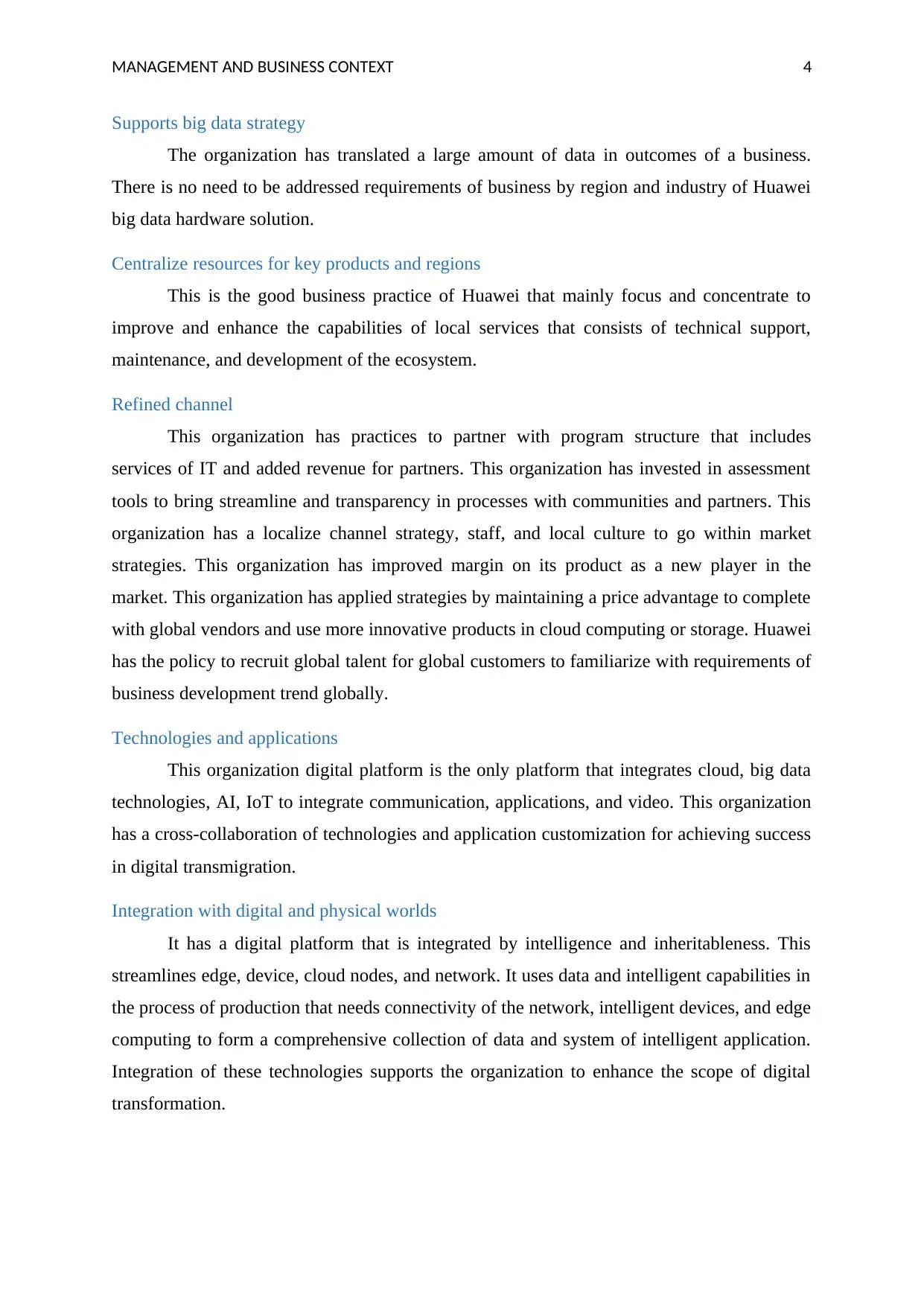
MANAGEMENT AND BUSINESS CONTEXT 4
Supports big data strategy
The organization has translated a large amount of data in outcomes of a business.
There is no need to be addressed requirements of business by region and industry of Huawei
big data hardware solution.
Centralize resources for key products and regions
This is the good business practice of Huawei that mainly focus and concentrate to
improve and enhance the capabilities of local services that consists of technical support,
maintenance, and development of the ecosystem.
Refined channel
This organization has practices to partner with program structure that includes
services of IT and added revenue for partners. This organization has invested in assessment
tools to bring streamline and transparency in processes with communities and partners. This
organization has a localize channel strategy, staff, and local culture to go within market
strategies. This organization has improved margin on its product as a new player in the
market. This organization has applied strategies by maintaining a price advantage to complete
with global vendors and use more innovative products in cloud computing or storage. Huawei
has the policy to recruit global talent for global customers to familiarize with requirements of
business development trend globally.
Technologies and applications
This organization digital platform is the only platform that integrates cloud, big data
technologies, AI, IoT to integrate communication, applications, and video. This organization
has a cross-collaboration of technologies and application customization for achieving success
in digital transmigration.
Integration with digital and physical worlds
It has a digital platform that is integrated by intelligence and inheritableness. This
streamlines edge, device, cloud nodes, and network. It uses data and intelligent capabilities in
the process of production that needs connectivity of the network, intelligent devices, and edge
computing to form a comprehensive collection of data and system of intelligent application.
Integration of these technologies supports the organization to enhance the scope of digital
transformation.
Supports big data strategy
The organization has translated a large amount of data in outcomes of a business.
There is no need to be addressed requirements of business by region and industry of Huawei
big data hardware solution.
Centralize resources for key products and regions
This is the good business practice of Huawei that mainly focus and concentrate to
improve and enhance the capabilities of local services that consists of technical support,
maintenance, and development of the ecosystem.
Refined channel
This organization has practices to partner with program structure that includes
services of IT and added revenue for partners. This organization has invested in assessment
tools to bring streamline and transparency in processes with communities and partners. This
organization has a localize channel strategy, staff, and local culture to go within market
strategies. This organization has improved margin on its product as a new player in the
market. This organization has applied strategies by maintaining a price advantage to complete
with global vendors and use more innovative products in cloud computing or storage. Huawei
has the policy to recruit global talent for global customers to familiarize with requirements of
business development trend globally.
Technologies and applications
This organization digital platform is the only platform that integrates cloud, big data
technologies, AI, IoT to integrate communication, applications, and video. This organization
has a cross-collaboration of technologies and application customization for achieving success
in digital transmigration.
Integration with digital and physical worlds
It has a digital platform that is integrated by intelligence and inheritableness. This
streamlines edge, device, cloud nodes, and network. It uses data and intelligent capabilities in
the process of production that needs connectivity of the network, intelligent devices, and edge
computing to form a comprehensive collection of data and system of intelligent application.
Integration of these technologies supports the organization to enhance the scope of digital
transformation.
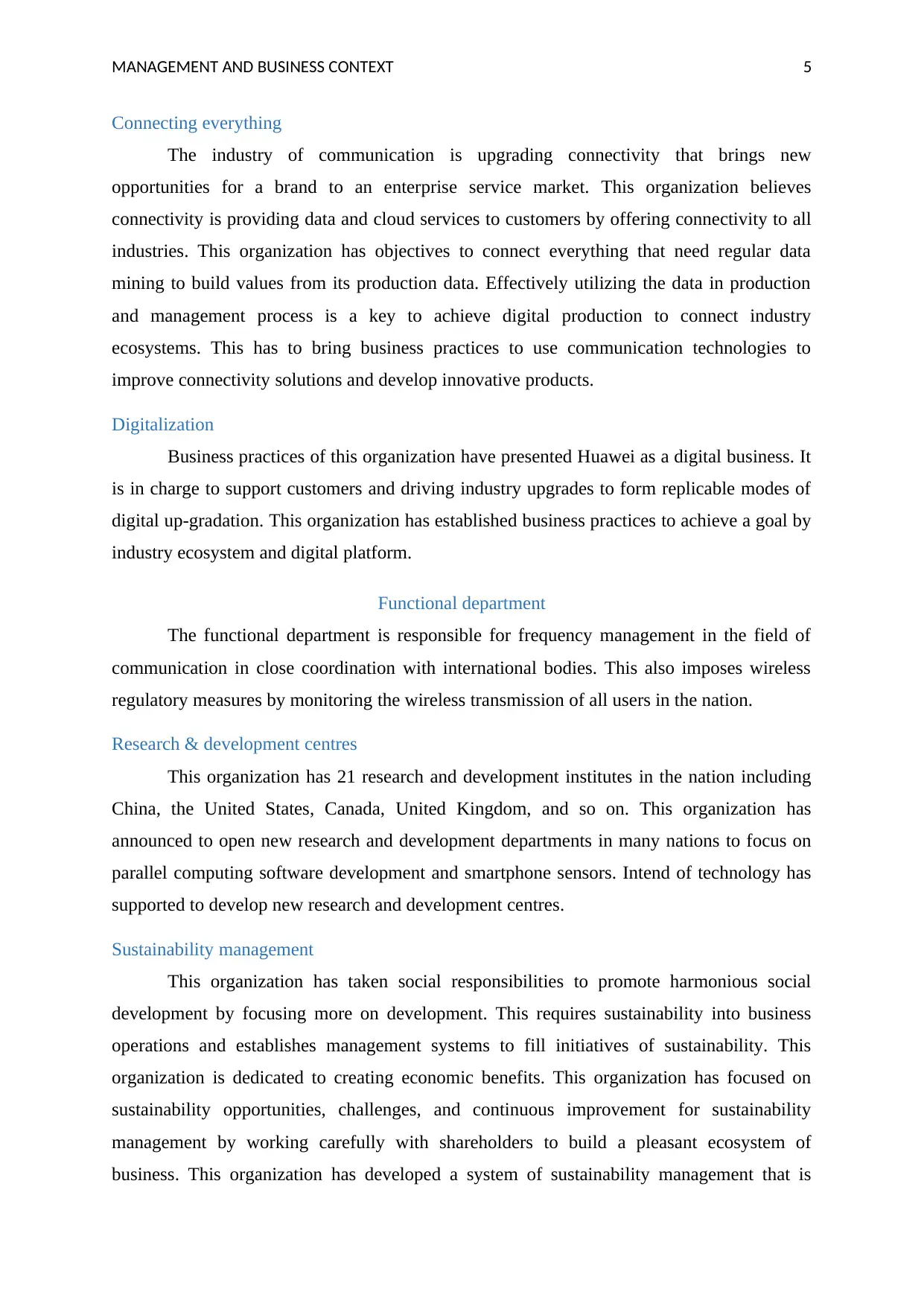
MANAGEMENT AND BUSINESS CONTEXT 5
Connecting everything
The industry of communication is upgrading connectivity that brings new
opportunities for a brand to an enterprise service market. This organization believes
connectivity is providing data and cloud services to customers by offering connectivity to all
industries. This organization has objectives to connect everything that need regular data
mining to build values from its production data. Effectively utilizing the data in production
and management process is a key to achieve digital production to connect industry
ecosystems. This has to bring business practices to use communication technologies to
improve connectivity solutions and develop innovative products.
Digitalization
Business practices of this organization have presented Huawei as a digital business. It
is in charge to support customers and driving industry upgrades to form replicable modes of
digital up-gradation. This organization has established business practices to achieve a goal by
industry ecosystem and digital platform.
Functional department
The functional department is responsible for frequency management in the field of
communication in close coordination with international bodies. This also imposes wireless
regulatory measures by monitoring the wireless transmission of all users in the nation.
Research & development centres
This organization has 21 research and development institutes in the nation including
China, the United States, Canada, United Kingdom, and so on. This organization has
announced to open new research and development departments in many nations to focus on
parallel computing software development and smartphone sensors. Intend of technology has
supported to develop new research and development centres.
Sustainability management
This organization has taken social responsibilities to promote harmonious social
development by focusing more on development. This requires sustainability into business
operations and establishes management systems to fill initiatives of sustainability. This
organization is dedicated to creating economic benefits. This organization has focused on
sustainability opportunities, challenges, and continuous improvement for sustainability
management by working carefully with shareholders to build a pleasant ecosystem of
business. This organization has developed a system of sustainability management that is
Connecting everything
The industry of communication is upgrading connectivity that brings new
opportunities for a brand to an enterprise service market. This organization believes
connectivity is providing data and cloud services to customers by offering connectivity to all
industries. This organization has objectives to connect everything that need regular data
mining to build values from its production data. Effectively utilizing the data in production
and management process is a key to achieve digital production to connect industry
ecosystems. This has to bring business practices to use communication technologies to
improve connectivity solutions and develop innovative products.
Digitalization
Business practices of this organization have presented Huawei as a digital business. It
is in charge to support customers and driving industry upgrades to form replicable modes of
digital up-gradation. This organization has established business practices to achieve a goal by
industry ecosystem and digital platform.
Functional department
The functional department is responsible for frequency management in the field of
communication in close coordination with international bodies. This also imposes wireless
regulatory measures by monitoring the wireless transmission of all users in the nation.
Research & development centres
This organization has 21 research and development institutes in the nation including
China, the United States, Canada, United Kingdom, and so on. This organization has
announced to open new research and development departments in many nations to focus on
parallel computing software development and smartphone sensors. Intend of technology has
supported to develop new research and development centres.
Sustainability management
This organization has taken social responsibilities to promote harmonious social
development by focusing more on development. This requires sustainability into business
operations and establishes management systems to fill initiatives of sustainability. This
organization is dedicated to creating economic benefits. This organization has focused on
sustainability opportunities, challenges, and continuous improvement for sustainability
management by working carefully with shareholders to build a pleasant ecosystem of
business. This organization has developed a system of sustainability management that is
⊘ This is a preview!⊘
Do you want full access?
Subscribe today to unlock all pages.

Trusted by 1+ million students worldwide
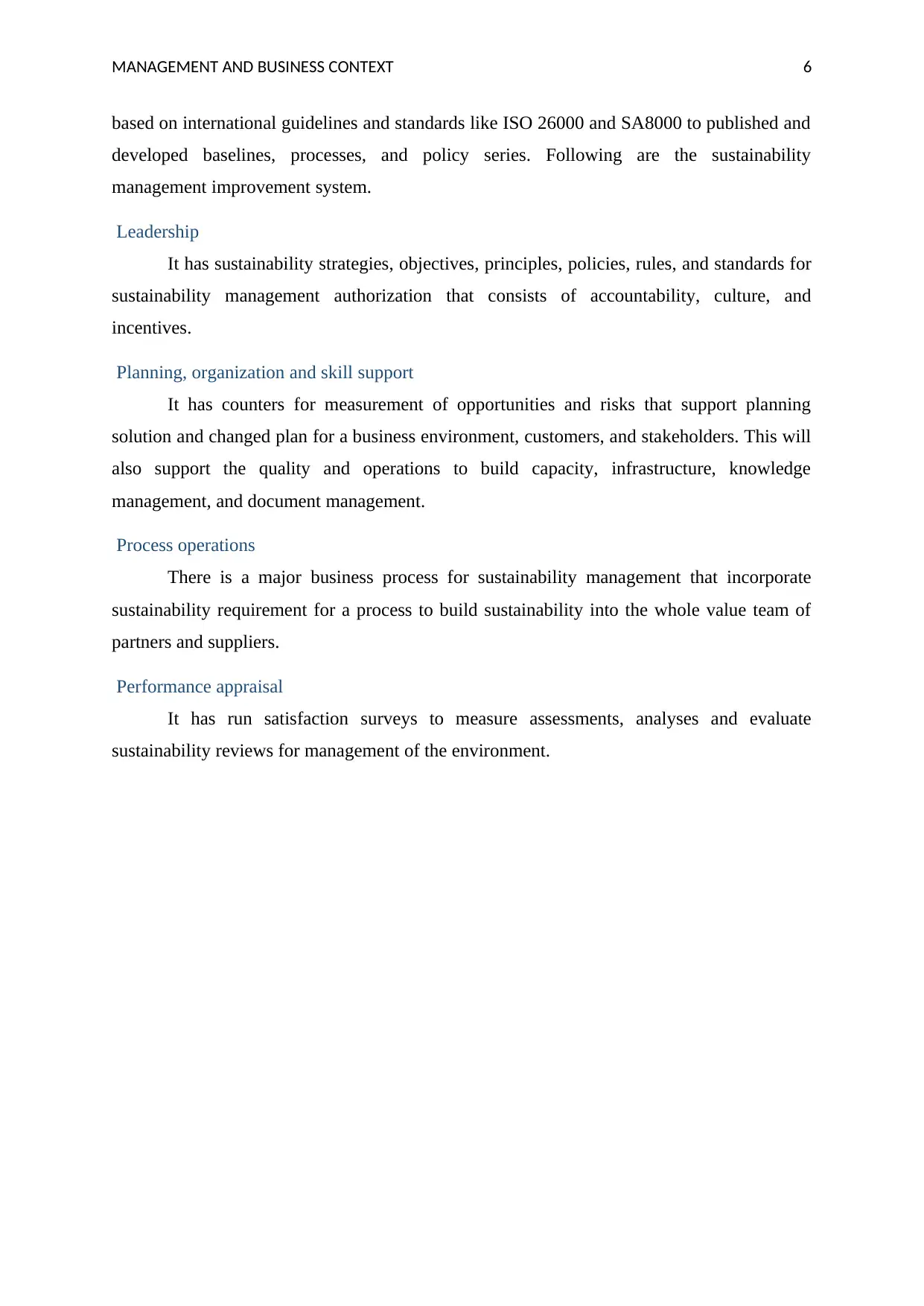
MANAGEMENT AND BUSINESS CONTEXT 6
based on international guidelines and standards like ISO 26000 and SA8000 to published and
developed baselines, processes, and policy series. Following are the sustainability
management improvement system.
Leadership
It has sustainability strategies, objectives, principles, policies, rules, and standards for
sustainability management authorization that consists of accountability, culture, and
incentives.
Planning, organization and skill support
It has counters for measurement of opportunities and risks that support planning
solution and changed plan for a business environment, customers, and stakeholders. This will
also support the quality and operations to build capacity, infrastructure, knowledge
management, and document management.
Process operations
There is a major business process for sustainability management that incorporate
sustainability requirement for a process to build sustainability into the whole value team of
partners and suppliers.
Performance appraisal
It has run satisfaction surveys to measure assessments, analyses and evaluate
sustainability reviews for management of the environment.
based on international guidelines and standards like ISO 26000 and SA8000 to published and
developed baselines, processes, and policy series. Following are the sustainability
management improvement system.
Leadership
It has sustainability strategies, objectives, principles, policies, rules, and standards for
sustainability management authorization that consists of accountability, culture, and
incentives.
Planning, organization and skill support
It has counters for measurement of opportunities and risks that support planning
solution and changed plan for a business environment, customers, and stakeholders. This will
also support the quality and operations to build capacity, infrastructure, knowledge
management, and document management.
Process operations
There is a major business process for sustainability management that incorporate
sustainability requirement for a process to build sustainability into the whole value team of
partners and suppliers.
Performance appraisal
It has run satisfaction surveys to measure assessments, analyses and evaluate
sustainability reviews for management of the environment.
Paraphrase This Document
Need a fresh take? Get an instant paraphrase of this document with our AI Paraphraser
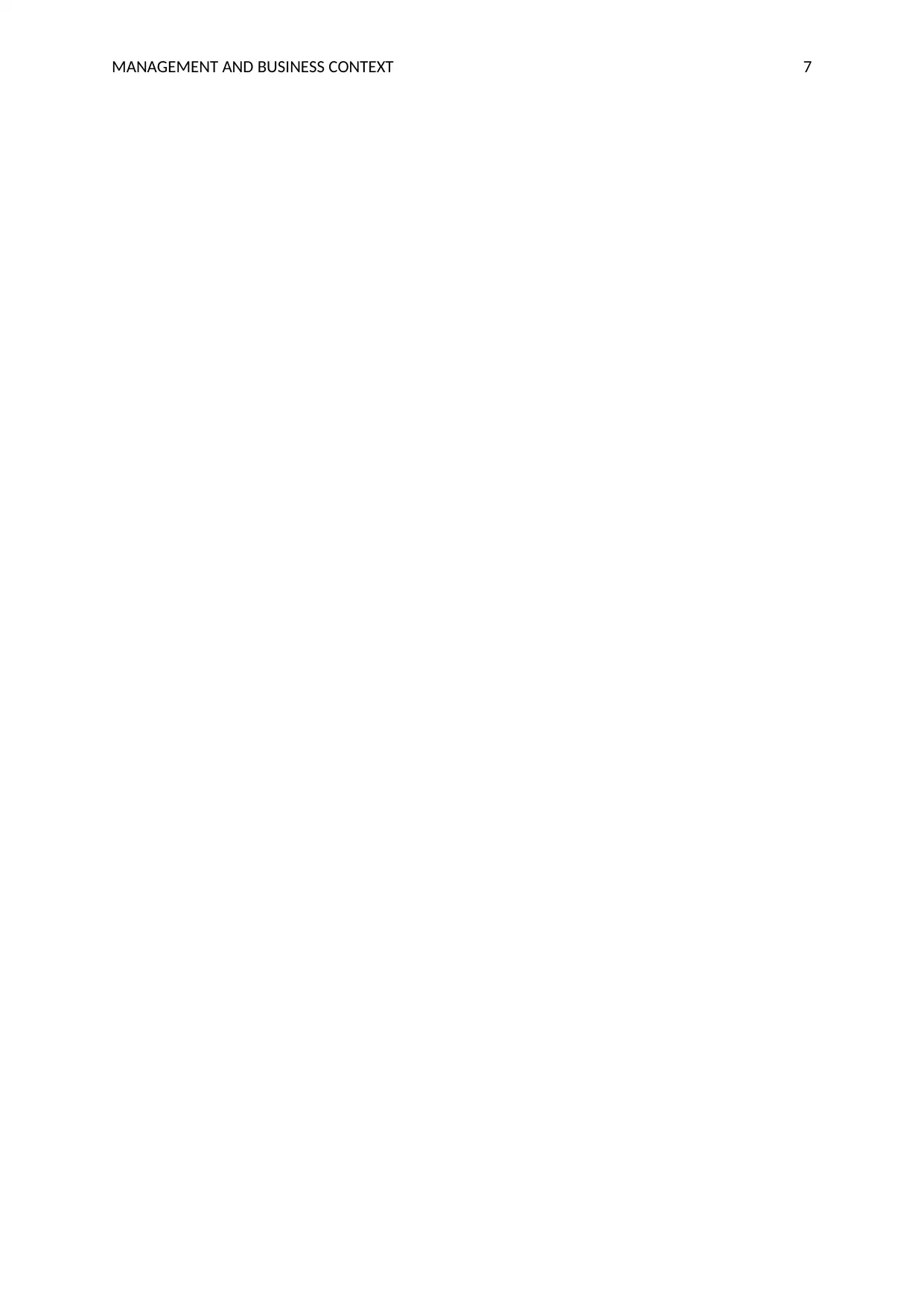
MANAGEMENT AND BUSINESS CONTEXT 7
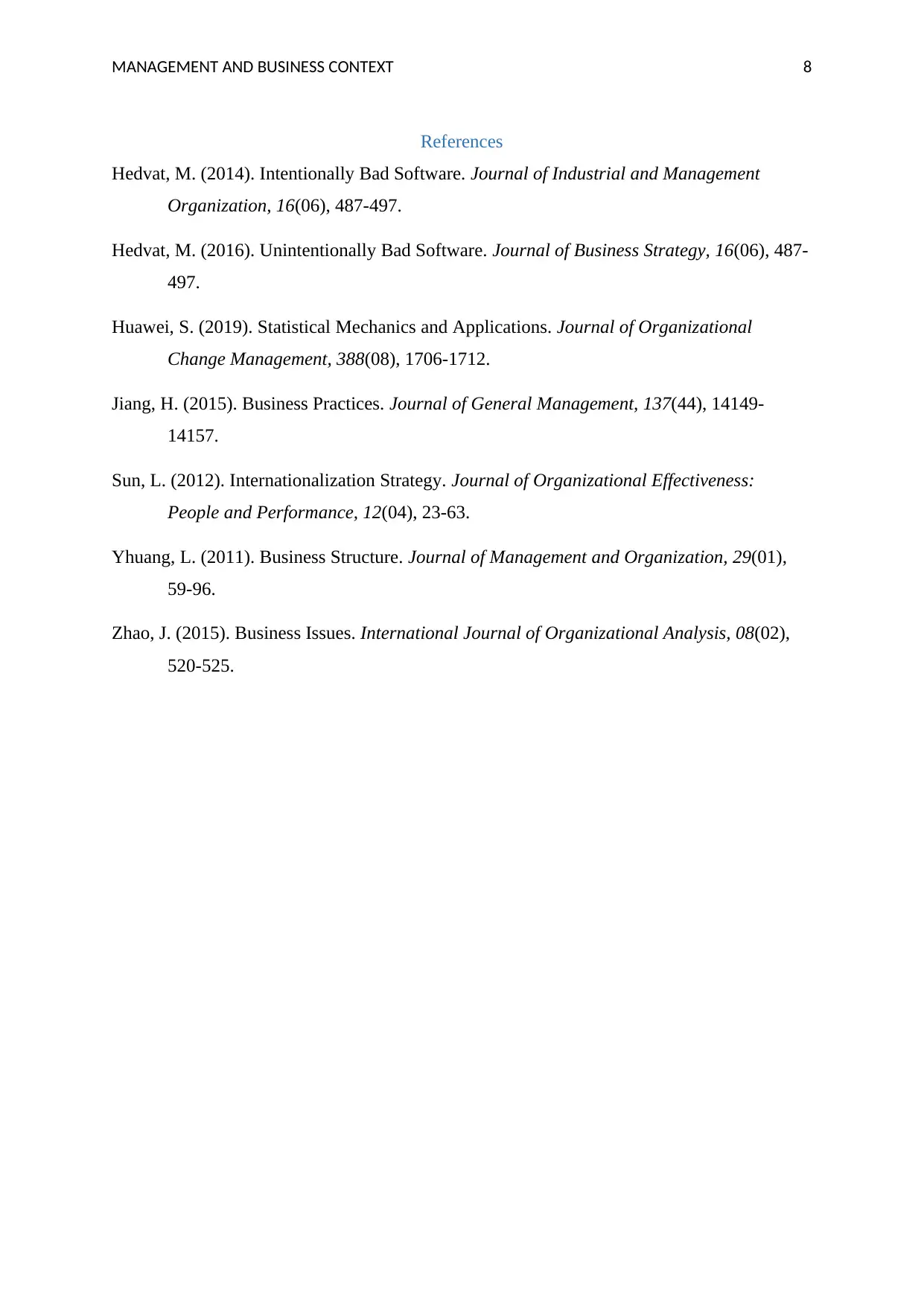
MANAGEMENT AND BUSINESS CONTEXT 8
References
Hedvat, M. (2014). Intentionally Bad Software. Journal of Industrial and Management
Organization, 16(06), 487-497.
Hedvat, M. (2016). Unintentionally Bad Software. Journal of Business Strategy, 16(06), 487-
497.
Huawei, S. (2019). Statistical Mechanics and Applications. Journal of Organizational
Change Management, 388(08), 1706-1712.
Jiang, H. (2015). Business Practices. Journal of General Management, 137(44), 14149-
14157.
Sun, L. (2012). Internationalization Strategy. Journal of Organizational Effectiveness:
People and Performance, 12(04), 23-63.
Yhuang, L. (2011). Business Structure. Journal of Management and Organization, 29(01),
59-96.
Zhao, J. (2015). Business Issues. International Journal of Organizational Analysis, 08(02),
520-525.
References
Hedvat, M. (2014). Intentionally Bad Software. Journal of Industrial and Management
Organization, 16(06), 487-497.
Hedvat, M. (2016). Unintentionally Bad Software. Journal of Business Strategy, 16(06), 487-
497.
Huawei, S. (2019). Statistical Mechanics and Applications. Journal of Organizational
Change Management, 388(08), 1706-1712.
Jiang, H. (2015). Business Practices. Journal of General Management, 137(44), 14149-
14157.
Sun, L. (2012). Internationalization Strategy. Journal of Organizational Effectiveness:
People and Performance, 12(04), 23-63.
Yhuang, L. (2011). Business Structure. Journal of Management and Organization, 29(01),
59-96.
Zhao, J. (2015). Business Issues. International Journal of Organizational Analysis, 08(02),
520-525.
⊘ This is a preview!⊘
Do you want full access?
Subscribe today to unlock all pages.

Trusted by 1+ million students worldwide
1 out of 9
Related Documents
Your All-in-One AI-Powered Toolkit for Academic Success.
+13062052269
info@desklib.com
Available 24*7 on WhatsApp / Email
![[object Object]](/_next/static/media/star-bottom.7253800d.svg)
Unlock your academic potential
Copyright © 2020–2025 A2Z Services. All Rights Reserved. Developed and managed by ZUCOL.




